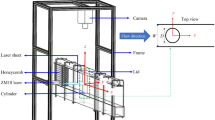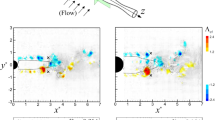Abstract
In the present work, the flow topologies of a generalized torpedo-like geometry were investigated experimentally via Particle Image Velocimetry (PIV) and dye visualization. The study was conducted at length based on the Reynolds number of Re = 20 × 103 and 40 × 103. The torpedo-like geometry was positioned at ratios of immersion between 0.50 ≤ h/D ≤ 3.50 to investigate the free-surface effect on the present results, comparatively. PIV measurements provided ensemble-averaged velocity fluctuations, turbulent kinetic energy and Reynolds stress correlation with spectral analysis of the vortex-shedding mechanism. It is observed that different vortex shedding mechanism occurs depending on the immersion ratio. At h/D = 0.5, wake flow is characterized by the lower shear layer while upper shear layer dominates it at h/D = 0.75 and 1.00. The influence of the free-surface on flow characteristics is found to be negligible at h/D > 2.00 for both Reynolds numbers. Alternating vortex shedding occurs and the wake regions at h/D = 3.5 became nearly symmetrical. The size of the wake zone is moved closer to the stern of the torpedo-like geometry at Re = 40 × 103 and causes a smaller recirculating region. Spectral analysis of the streamwise velocity revealed a decreasing trend of Strouhal number with increasing immersion ratios. The changing of the Strouhal number showed a significant increase at h/D = 0.75 for Re = 20 × 103 an ever-decreasing trend for Re = 40 × 103.















Similar content being viewed by others
References
Myring DF (1976) Theoretical study of body drag in subcritical axisymmetric flow. Aeronaut Q 27(3):186–194
Alvarez A, Caffaz A, Caiti A, Casalino G, Gualdesi L, Turetta A, Viviani R (2009) Fòlaga: A low-cost autonomous underwater vehicle combining glider and AUV capabilities. Ocean Eng 36(1):24–38. https://doi.org/10.1016/j.oceaneng.2008.08.014
Kukulya A, Plueddemann A, Austin T, Stokey R, Purcell M, Allen B, Pietro J (2010) Under-ice operations with a REMUS-100 AUV in the arctic. IEEE/OES Autonomous Underwater Vehicles, 2010, pp. 1-8. https://doi.org/10.1109/AUV.2010.5779661
Carreras M, Candela C, Ribas D, Palomeras N, Magií L, Mallios A, Ridao P (2018) Testing SPARUS II AUV, an open platform for industrial, scientific and academic applications. arXiv preprint. arXiv:1811.03494
Koren S, Arieli R, Rom J (1992) Measurements of lateral aerodynamics characteristics of forebodies at high angle of attack in subsonic and transonic flows. In: 30th Aerospace Sciences Meeting and Exhibit. https://doi.org/10.2514/6.1992-174
Shi Y, Pan G, Yan-., Yim, S. C., & Jiang, J. G (2019) Numerical study on the cavity characteristics and impact loads of AUV water entry. Appl Ocean Res 89:44–58. https://doi.org/10.1016/j.apor.2019.05.012
Drew, B. A. (2002). Measurement methods and analysis: Forces on underwater gliders. U.S.N.A.-Trident Scholar project report, no. 293
Gao T, Wang Y, Pang Y, Cao J (2016) Hull shape optimization for autonomous underwater vehicles using CFD. Eng Appl Comput Fluid Mech 10(1):599–607. https://doi.org/10.1080/19942060.2016.1224735
Bridges DH, Blanton JN, Brewer WH, Park JT (2003) Experimental investigation of the flow past a submarine at angle of drift. AIAA J 41(1):71–81. https://doi.org/10.2514/2.1915
Jagadeesh P, Murali K, Idichandy VG (2009) Experimental investigation of hydrodynamic force coefficients over AUV hull form. Ocean Eng 36(1):113–118. https://doi.org/10.1016/j.oceaneng.2008.11.008
Gross A, Jagadeesh C, Fasel HF (2013) Numerical and experimental investigation of unsteady three-dimensional separation on axisymmetric bodies. Int J Heat Fluid Flow 44:53–70. https://doi.org/10.1016/j.ijheatfluidflow.2013.04.016
Bal S (2011) The effect of finite depth on 2d and 3d cavitating hydrofoils. J Mar Sci Technol 16(2):129–142. https://doi.org/10.1007/s00773-011-0117-2
Oshkai P, Rockwell D (1999) Free surface wave interaction with a horizontal cylinder. J Fluids Struct 13(7–8):935–954. https://doi.org/10.1006/jfls.1999.0237
Reichl P, Hourigan K, Thompson M (2003) The unsteady wake of a circular cylinder near a free surface. Flow Turbul Combust 71(1–4):347–359. https://doi.org/10.1023/B:APPL.0000014926.99751.b1
Lin-., & Huang, L. -. M (2010) Free-surface flow past a submerged cylinder. J Hydrodyn 22(5 SUPPL. 1):209–214. https://doi.org/10.1016/S1001-6058(09)60195-5
Doğan S, Özgören M, Okbaz A, Şahin B, Akıllı H (2018) Investigation of interactions between a sphere wake and free surface. J Fac Eng Arch Gazi Univ 33(3):1123–1133. https://doi.org/10.17341/gazimmfd.453552
Shariati SK, Mousavizadegan SH (2017) The effect of appendages on the hydrodynamic characteristics of an underwater vehicle near the free surface. Appl Ocean Res 67:31–43. https://doi.org/10.1016/j.apor.2017.07.001
Amiri MM, Esperança PT, Vitola MA, Sphaier SH (2018) How does the free surface affect the hydrodynamics of a shallowly submerged submarine? Appl Ocean Res 76:34–50. https://doi.org/10.1016/j.apor.2018.04.008
Salari M, Rava A (2017) Numerical investigation of hydrodynamic flow over an AUV moving in the water-surface vicinity considering the laminar-turbulent transition. J Mar Sci Appl 16(3):298–304. https://doi.org/10.1007/s11804-017-1422-x
Amiri MM, Sphaier SH, Vitola MA, Esperança PT (2019) URANS investigation of the interaction between the free surface and a shallowly submerged underwater vehicle at steady drift. Appl Ocean Res 84:192–205. https://doi.org/10.1016/j.apor.2019.01.012
Phillips AB, Turnock SR, Furlong M (2010) Influence of turbulence closure models on the vortical flow field around a submarine body undergoing steady drift. J Mar Sci Technol 15(3):201–217. https://doi.org/10.1007/s00773-010-0090-1
Kilavuz A, Ozgoren M, Durhasan T, Sahin B, Kavurmacioglu L, Akilli H, Sarigigüzel F (2019) Analysis of attack angle effect on flow characteristics around torpedo-like geometry placed near the free-surface via CFD. J Polytech. https://doi.org/10.2339/politeknik.675632
Wang G, Senocak I, Shyy W, Ikohagi T, Cao S (2001) Dynamics of attached turbulent cavitating flows. Prog Aerosp Sci 37(6):551–581. https://doi.org/10.1016/s0376-0421(01)00014-8
Senocak I, Shyy W (2002) A pressure-based method for turbulent cavitating flow computations. J Comput Phys 176(2):363–383. https://doi.org/10.1006/jcph.2002.6992
Das HN, Rao N, Suman KNS, Prasad VVS (2006) Performance prediction of elliptical head form profile of a submerged body. J Inst Eng 86:46–49
Cheng MA, Jia D, Qian Z, Feng D (2006) Study on cavitation flows of underwater vehicle. J Hydrodyn Ser B 18(3):373–377. https://doi.org/10.1016/s1001-6058(06)60081-4
Terentiev AG, Kirschner IN, Uhlman JS (2011) The Hydrodynamics of Cavitating Flows, Backbone Publishing Company, U.S.A
de Henriques TA, J., Hedges T. S., Owen I., Poole R. J. (2016) The influence of blade pitch angle on the performance of a model horizontal axis tidal stream turbine operating under wave current interaction. Energy 102:166–175
Aghsaee P, Markfort CD (2018) Effects of flow depth variations on the wake recovery behind a horizontal-axis hydrokinetic in-stream turbine. Renew Energy 125:620–629
Nishino T, Willden RHJ (2013) Two-scale dynamics of flow past a partial cross-stream array of tidal turbines. J Fluid Mech 730:220–244
Churchfield MJ, Li Y, Moriarty PJ (2013) A large-eddy simulation study of wake propagation and power production in an array of tidal-current turbines. Phil Trans R Soc A 371:20120421
Gupta V, Wan M (2019) Low-order modelling of wake meandering behind turbines. J Fluid Mech 877:534–560
Hu Q, Li Y, Di Y, Chen J (2017) A large-eddy simulation study of horizontal axis tidal turbine in different inflow conditions. J Renew Sustain Energy 9:064501
Li Z, Ghia K, Li Y, Fan Z, Shen L (2021) Unsteady Reynolds-averaged Navier-Stokes investigation of free surface wave impact on tidal turbine wake. Proc R Soc A 477:20200703
Westerweel J (1994) Efficient detection of spurious vectors in particle image velocimetry data. Exp Fluids 16(3–4):236–247. https://doi.org/10.1007/BF00206543
Raffel M, Willert CE, Scarano F, Kähler CJ, Wereley ST, Kompenhans J (2018) PIV uncertainty and measurement accuracy. Particle Image Velocimetry. Springer, Cham, pp 203–241
Ozgoren M (2006) Flow structure in the downstream of square and circular cylinders. Flow Meas Instrum 17(4):225–235. https://doi.org/10.1016/j.flowmeasinst.2005.11.005
Kilavuz A, Sarigiguzel F, Ozgoren M, Durhasan T, Sahin B, Kavurmacioglu LA, Sekeroglu E, Yaniktepe B (2022) The impacts of the free-surface and angle of attack on the flow structures around a torpedo-like geometry. Eur J Mech B/Fluids 92:226–243
Sarigiguzel F, Kilavuz A, Ozgoren M, Durhasan T, Sahin B, Kavurmacioglu LA, Sekeroglu E, Yaniktepe B (2022) Experimental Investigation of Free-surface Effects on Flow Characteristics of a Torpedo-Like Geometry Having a Cambered Nose. Ocean Eng 253:111174. https://doi.org/10.1016/j.oceaneng.2022.111174
Acknowledgements
The authors would like to acknowledge the Scientific and Technological Research Council of Turkey (TUBITAK) under Contract No. 214M318 and Cukurova University Scientific Research Project Coordinators (BAP) under Contract No. FYL-2019-11596. It is a pleasure to thank the Mechanical Engineering Department of Cukurova University and the Advanced Fluid Mechanics PIV laboratory of Osmaniye Korkut Ata University, Turkey for letting the authors conduct this experimental work.
Funding
türkiye bilimsel ve teknolojik araştirma kurumu,214M318,Muammer Ozgoren
Author information
Authors and Affiliations
Corresponding author
Additional information
Publisher's Note
Springer Nature remains neutral with regard to jurisdictional claims in published maps and institutional affiliations.
About this article
Cite this article
Kilavuz, A., Durhasan, T., Ozgoren, M. et al. Influence of free-surface on wake flow characteristics of a torpedo-like geometry. J Mar Sci Technol 27, 1130–1147 (2022). https://doi.org/10.1007/s00773-022-00893-7
Received:
Accepted:
Published:
Issue Date:
DOI: https://doi.org/10.1007/s00773-022-00893-7




